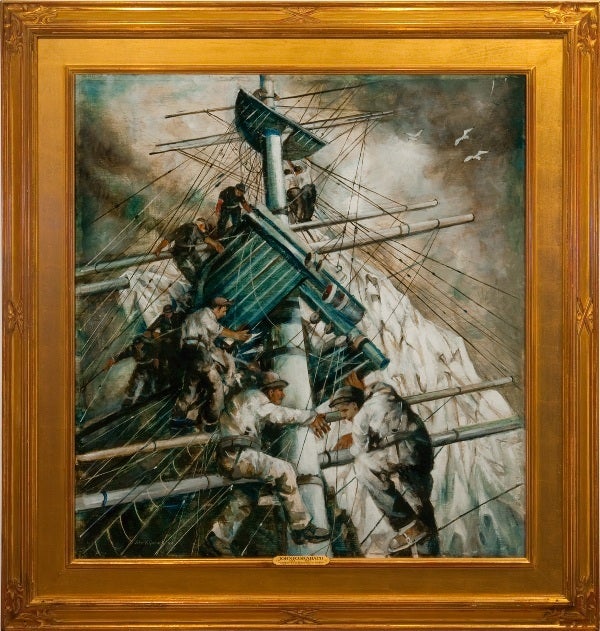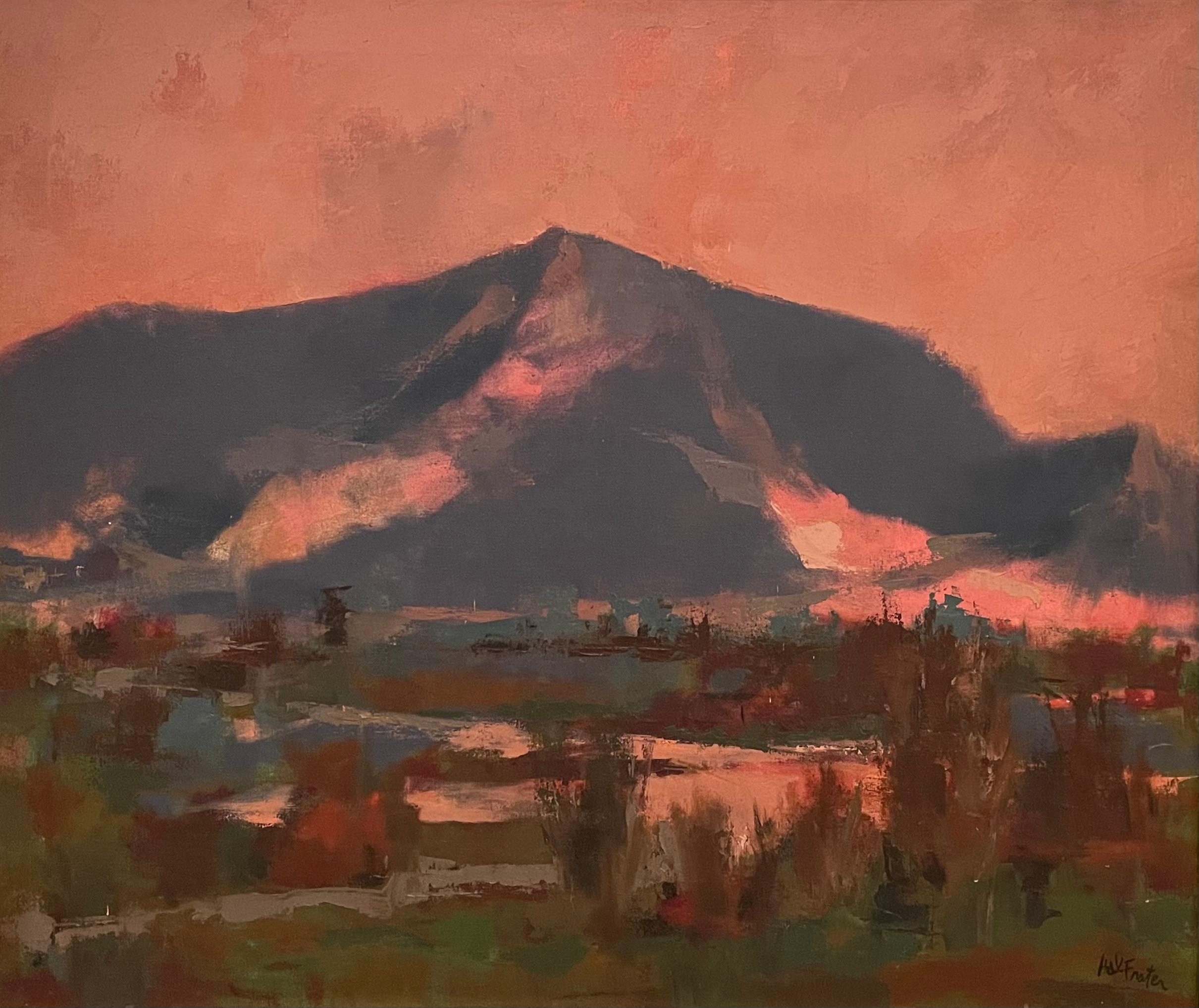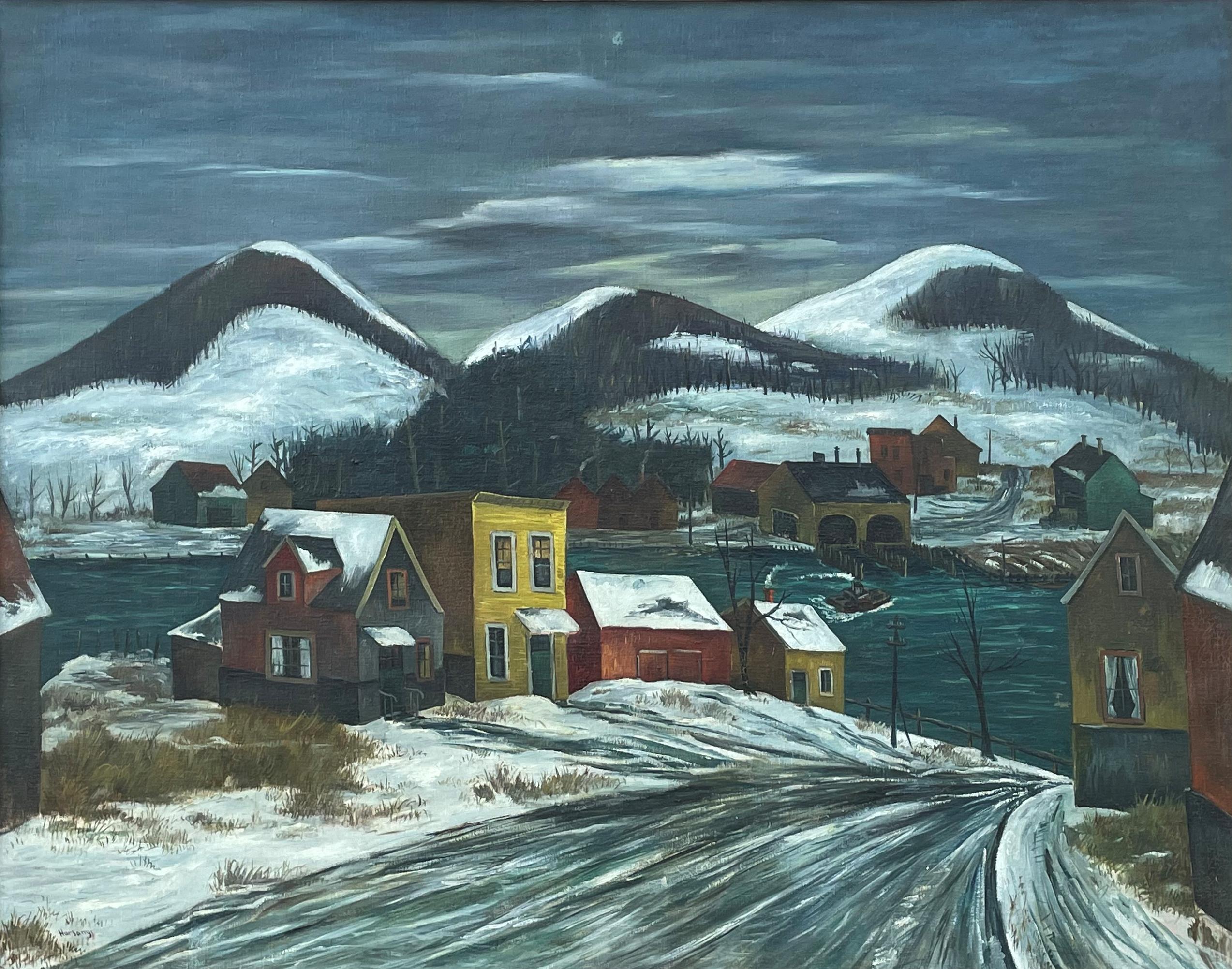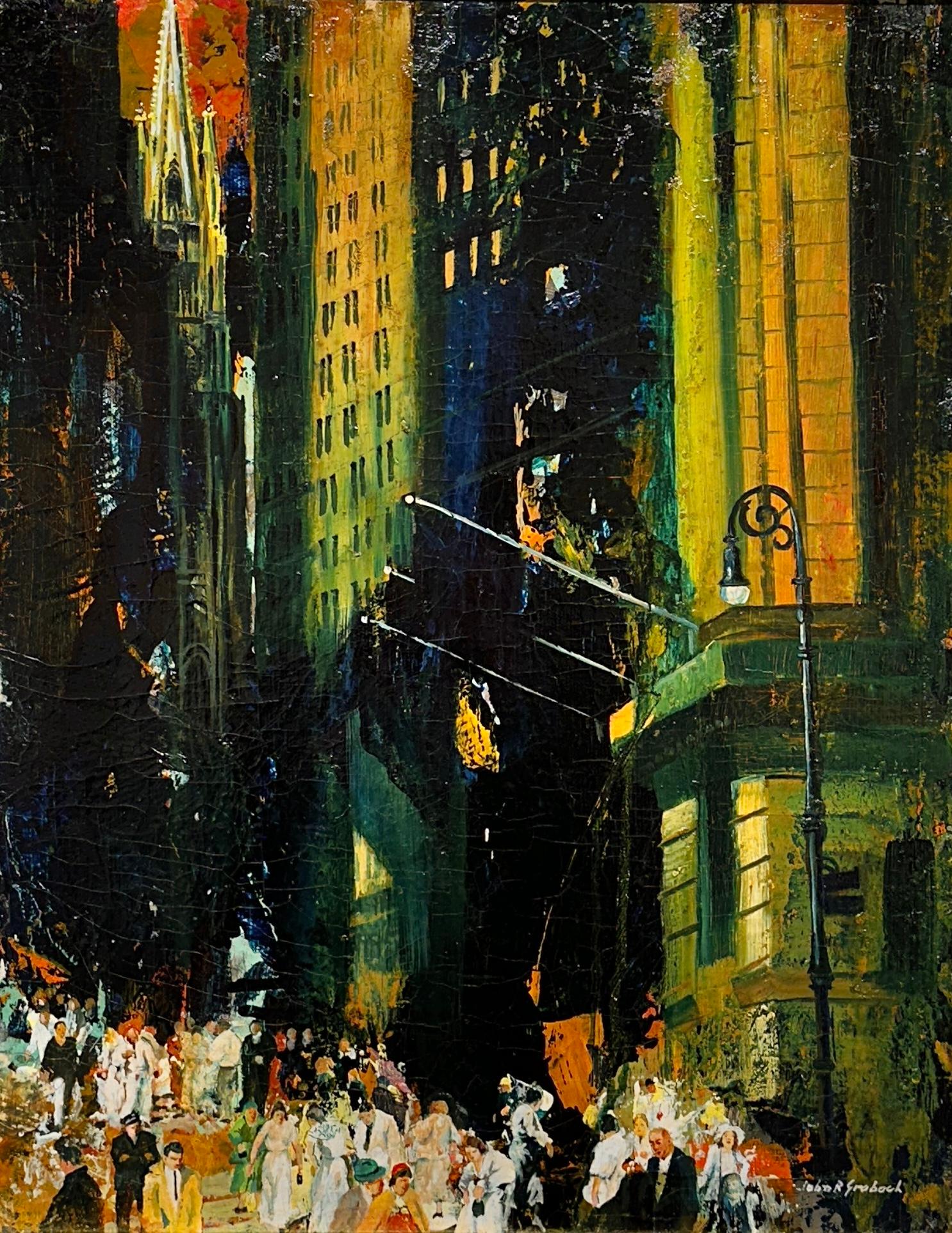Items Similar to Revolutionary Guard House for General Putnam's Army, West Redding, Connecticut
Want more images or videos?
Request additional images or videos from the seller
1 of 9
Leon KrollRevolutionary Guard House for General Putnam's Army, West Redding, Connecticut1911
1911
About the Item
Leon Kroll
Revolutionary Guard House for General Putnam's Army, West Redding, Connecticut, 1911
Signed and dated lower right
Oil on panel
8 1/2 x 10 3/4 inches
Provenance:
Private Collection
(with) Lois Wagner Fine Art, New York
Exhibited:
Ogunquit, Maine, Ogunquit Museum of American Art, The Art of Leon Kroll, July 1 - August 13, 2002.
Leon Kroll was born in New York City in 1884. He studied art at both the National Academy of Design and the Art Students League. Kroll received a scholarship to study at the Byrdcliffe art colony in Woodstock the summer of 1906 and a National Academy scholarship to study in Europe in 1908. Kroll used the scholarship to travel to Belgium, Holland, and Germany the summer of 1908 before settling in Paris in the fall to study at the Académie Julian with Jean-Paul Laurens. Returning to New York in the fall of 1910, Kroll received his first one-man exhibition at the National Academy with 85 paintings.
Upon his return to New York, Kroll met George Bellows and was introduced to Robert Henri, John Sloan, and their post-Eight circle. Kroll was the only young artist of the group who had not studied with Henri and his National Academy training was considered anathema to the Eight’s founding, yet he was embraced by the group and featured in their exhibitions. Kroll’s popularity as an artist grew and his lush brushwork, exciting compositions, and Fauve palette gained him the opportunity to exhibit at the famous 1913 Armory Show, at which he sold all of his paintings.
Leon Kroll and George Bellows painted together on Monhegan Island in Maine in 1913 and returned to the Maine coast the summers of 1915 and 1916. Kroll was invited to Colorado to paint five portraits of the Travis family in 1917. While there, Kroll painted at least ten hours a day, using any spare time from the portraits as a chance to paint the surrounding Rocky Mountains. Already out west, Kroll joined George Bellows and Robert Henri in Santa Fe, New Mexico to paint the local scenery the summer of 1917. During the Teens, Kroll was fascinated by Cézanne and broke up his realist compositions into more geometrical forms.
In 1920 Kroll returned to Woodstock for the summer at the suggestion of George Bellows. In Kroll’s autobiography A Spoken Memoir he recalls frequently hosting fellow Woodstockers the Bellowses and the Speichers for dinners, as well as Robert Henri when he came up to teach at the Art Students League summer program. Kroll spent the summers of 1921 and 1924 in Woodstock as well. From 1925 to 1929 Kroll spent much of his time in France as his new wife was from Paris. Kroll was a leading artist of the 1920s. His still-life and figurative subjects, as well as scenes of New York City, were regularly exhibited both at his New York dealer Rehn Gallery and museum invitationals. He had a large one-man exhibition of 31 paintings at the Art Institute of Chicago in December 1924-January 1925 alongside George Bellows who exhibited 22 paintings.
In the 1930s, Kroll executed some of his best landscape and figurative works over summers in Cape Ann, Massachusetts. He often stretched the season, staying late into the fall to continue his painting. The Carnegie Institute gave Kroll a retrospective in 1935 and the Worcester Art Museum had a solo exhibition in 1937.
In 1938 Kroll sought the quiet of a studio in Bearsville to work on the design for an extensive mural on the First World War for the War Memorial Building in Worcester, Massachusetts. Kroll and his family then lived in Worcester from 1939 to 1941 for Kroll to execute the murals. The largest panel in the series was 30 x 57 feet. Kroll also created murals for the Department of Justice in Washington, DC (1935); the State Capitol of Indiana (1951); and the Omaha Beach War Memorial in France (1952).
Kroll received many awards throughout his career, including early recognition at the Art Institute of Chicago with its purchase prize, the Logan Prize, in 1919 and at the National Academy of Design with the Thomas E. Clark Prize in 1921. He went on to receive further prizes at the National Academy and the Art Institute of Chicago in the 1920s followed by a gold medal at the Pennsylvania Academy of the Fine Arts, first prize in the American section of the Pan-American Exposition in Baltimore in 1931, and first prize at the Carnegie International in 1936.
His memberships included the American Academy of Arts and Letters, Boston Art Club, National Academy of Design, National Arts Club, National Institute of Arts and Letters, New Society of Artists, New Society of Etchers, New York Society of Etchers, Philadelphia Art Club, Salmagundi Club, and the Society of Independent Artists. Kroll’s work can be seen in the permanent collections of the Art Institute of Chicago, IL; Baltimore Museum of Art, MD; Corcoran Gallery of Art, Washington, DC; Dayton Art Institute, OH; Indianapolis Museum of Art, IN; Los Angeles County Museum, CA; Metropolitan Museum of Art, NY; Pennsylvania Academy of the Fine Arts, PA; and the Whitney Museum of American Art, NY.
- Creator:Leon Kroll (1884-1975, American)
- Creation Year:1911
- Dimensions:Height: 12 in (30.48 cm)Width: 14 in (35.56 cm)
- Medium:
- Movement & Style:
- Period:
- Condition:
- Gallery Location:New York, NY
- Reference Number:1stDibs: LU1841213195642
About the Seller
5.0
Platinum Seller
These expertly vetted sellers are 1stDibs' most experienced sellers and are rated highest by our customers.
Established in 2021
1stDibs seller since 2022
59 sales on 1stDibs
Typical response time: 1 hour
- ShippingRetrieving quote...Ships From: New York, NY
- Return PolicyA return for this item may be initiated within 3 days of delivery.
More From This SellerView All
- "Portland Harbor, Maine, " Alexander Bower, Snowy River Scene in WinterBy Alexander BowerLocated in New York, NYAlexander Bower (1875 - 1952) Portland Harbor, Maine, 1910 Oil on canvas 27 x 33 inches Signed and dated lower right An American Impressionist, Alexande Bower was born in New York, studied at The Pennsylvania Academy of Fine Art, and was living with his wife in Cliff Island, Maine by 1914. Despite his urban upbringing, the coast and the sea fascinated Bower. A large portion of his paintings are seascapes, particularly scenes depicting the coast of Cape Elizabeth...Category
1910s Ashcan School Landscape Paintings
MaterialsCanvas, Oil
- "The Ferry No. 2, " Charles Harsanyi, Modern, Large WPA Ashcan Landscape SceneBy Charles E. HarsanyiLocated in New York, NYCharles E. Harsanyi (1905 - 1973) The Ferry No. 2, 1946 Oil on canvas 40 x 52 inches Signed, titled and dated on the reverse Provenance: The artist Grand Central Art Galleries, New York Private Collection, New York Kappell Gallery, Greenport, New York Private Collection, Long Island, circa 2002 Exhibited: New York, Grand Central Art Galleries, Critics' Show, December 10 - 21, 1946. Charles E. Harsanyi was born in Tapolcza, Hungary in 1905. He studied at the Royal Academy in Budapest, Hungary with A. Bankhard from 1923 to 1928. Nineteen years later, in 1947, Harsanyi moved to the U. S., settling in Jackson Heights, New York. The painter and drawing specialist became a member of numerous prestigious art clubs including the Salmagundi Club, The Society of Independent Artists and the Allied Artists of America. Harsanyi served as an awards director and chairman of admissions for the Audubon Artists Association during the 1950s. Later in life after living in Stephentown, New York and Cape Coral...Category
1940s Ashcan School Landscape Paintings
MaterialsCanvas, Oil
- "On the Beach, " Nicolai Cikovsky, American Impressionism, Landscape SeascapeBy Nicolai CikovskyLocated in New York, NYNicolai S. Cikovsky (1894 - 1984) On the Beach Oil on panel 15 1/4 x 20 inches Signed lower right Provenance: ACA Galleries, New YorkCategory
Mid-20th Century American Impressionist Landscape Paintings
MaterialsOil, Panel
- "MacMahan's Maine, " Howard Everett Giles, Figurative Landscape, ImpressionismLocated in New York, NYHoward Everett Giles (1876 - 1955) MacMahan's Maine Oil on canvas backed with board 30 x 30 inches Signed lower right Provenance: Art Institute of Chicago Christie's New York, December 8, 2011, Lot 2 Howard Giles spent most of his career in New York City, where he was an educator, magazine illustrator, and painter who espoused the theory of Dynamic Symmetry. He was born in Brooklyn, and as a young man worked in a New York railroad office. Financial support of a family friend allowed him to study at the Art Students League with H. Siddons Mowbray. In early 1910, he became an illustrator for Scribner's Magazine, and in 1912, on sketching assignment for Scribner's went to England. During World War I, he did illustration for Harper's Monthly Magazine, and many of his images were 'roaring twenties' genre and figure paintings. In 1912, he began teaching life classes at the New York School of Fine and Applied Arts (later Parsons School of Design), and remained there until the late 1920s. During that time, he was also a part-time instructor at the Childs-Walker School in Boston, and accepted numerous invitations to lecture including at Carnegie Institute in Pittsburgh, Pennsylvania Academy of the Fine Arts, Detroit Institute of Arts and Wellesley College. His initial painting style was Impressionism, but he grew increasingly interested in other scientific, aesthetic theories. He worked with Jay Hambridge from 1916 to 1919, applying Hambridge's theory of Dynamic Symmetry to his painting and his lecture topics. From 1922 to 1926, Giles also worked with and was influenced in his own painting by colorist theorist Denman Ross, who espoused a limited and related color palette. For many of his paintings, Giles used watercolor although he also painted in oil and pastels. During the last years before his retirement when he moved to Woodstock...Category
Early 20th Century American Impressionist Landscape Paintings
MaterialsOil, Panel
- "Parisian Nocturne, France, " Frank Edwin Scott, American ImpressionismBy Frank Edwin ScottLocated in New York, NYEdwin Frank Scott (1863 - 1929) Parisian Noctune, France Oil on woof panel 8 1/4 x 10 1/2 inches Signed lower left Born in Buffalo, New York, Edwin Frank ...Category
Late 19th Century American Impressionist Landscape Paintings
MaterialsOil, Wood Panel
- "Nantucket, Massachusetts" Helen Goodwin, American Impressionism Docks at HarborLocated in New York, NYHelen M. Goodwin (1865 - 1955) Nantucket, Massachusetts Oil on canvas laid on panel 12 x 16 inches Signed and titled lower right Helen M. Goodwin was born in New Castle, Indiana in ...Category
Early 20th Century American Impressionist Landscape Paintings
MaterialsOil, Panel, Canvas
You May Also Like
- "After the Storm"By John R. GrabachLocated in Lambertville, NJSigned LL John Grabach was a highly regarded New Jersey artist, teacher and author of a classic text, How to Draw the Human Figure. He was born in Massachusetts, and with his widow...Category
20th Century Ashcan School Figurative Paintings
MaterialsOil, Panel
- Under the HollowBy Alexander Oscar LevyLocated in Buffalo, NYAn important American modern landscape by Ashcan school artist Alexander O. Levy. This painting was featured in the retrospective for the artist held at the Burchfield Penney Art Ce...Category
1930s Ashcan School Landscape Paintings
MaterialsCanvas, Oil
- 'Pink Sky' by Hal Frater - Mountain Range at Dusk - Oil Painting on CanvasBy Hal FraterLocated in Carmel, CAHal Frater's "Pink Sky" is a moody landscape that masterfully captures the play of light at dusk. Dominated by a majestic mountain under a vast, dusky sky, the painting is steeped in...Category
1970s Ashcan School Landscape Paintings
MaterialsCanvas, Oil
- New York scene done by John Grabach Artist "Trinity Church - Wall Street"Located in Rockport, MAGreat Wall Street piece by John R. Grabach (March 2, 1886 – March 17, 1981) with expressive colors and figures. Grabach was a renowned American painter, best known for his evocative...Category
1920s Ashcan School Figurative Paintings
MaterialsOil
- Outside a DeliBy Jack LevineLocated in Sheffield, MAJack Levine American, 1915-2010 The Deli Oil on board 28 ¼ by 34 in. W/frame 36 ¼ by 42 in. Signed Lower Right Born and raised in the south end of Boston, Jack Levine created soc...Category
1940s Ashcan School Figurative Paintings
MaterialsOil
- White Cloud and RockBy John SloanLocated in New York, NYKnown as the “dean of American artists,” John Sloan was one of the most influential members of the Ashcan school.Category
1910s Ashcan School Landscape Paintings
MaterialsOil
Recently Viewed
View AllMore Ways To Browse
Robert Indiana Eight
Colorado Fauve Landscape
Farm House Art
Gas Light Los Angeles
Be Prompt To Class
Nagoya Chair
Red Sailboat Painting
Vision Of Gala
Unicorn Oil Painting
Tall Antique Oil Painting
Provencal Village Painting
Red Parasol
Halle Bros
Pueblo Christmas
Nicola L Eye Light
Pennsylvania Sellers
Waterlily Oil Painting
Robert Redbird



